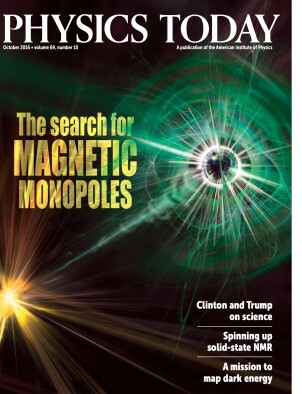Between research and development: IBM and Josephson computing
DOI: 10.1063/PT.3.3327
The early 1960s were a period of intense ferment in superconductivity research. In 1957 John Bardeen, Leon Cooper, and J. Robert Schrieffer at the University of Illinois offered the first microscopic theory of superconductivity. Around the same time Alexei Abrikosov at the Institute for Physical Problems in Moscow explained phenomenologically how certain materials can admit some magnetic flux without losing their superconductivity. Experimentally, techniques for growing superconducting films were improving rapidly at the corporate laboratories of firms such as General Electric (GE), Ford Motor Co, Arthur D. Little, and AT&T.
Thus when future Nobel laureate Philip Anderson took a sabbatical from Bell Laboratories in 1961–62 to teach at Cambridge University, he encountered a classroom of graduate students eager to learn about the latest developments in low-temperature physics. Even among those high achievers, one student stood out: a brusque, brilliant 22-year-old named Brian Josephson. As Anderson wrote in Physics Today (November 1970, page 23
A few months after Anderson’s arrival in Cambridge, Josephson approached him with calculations of the behavior of electrons as they traveled through a superconducting wire interrupted by a very thin insulating barrier—behavior later known as the Josephson effect. Josephson made several predictions, the most well known of which is that if the barrier is thin enough, pairs of electrons can tunnel through it together without resistance to form a supercurrent. Josephson also showed that if a voltage is placed across the barrier, then the supercurrent will be an alternating current with microwave frequency.
The story of Josephson and Anderson’s meeting, the articulation of the Josephson effect, and Josephson’s colorful career both before and after sharing the 1973 Nobel Prize in Physics at age 33 have entered physicists’ communal oral tradition. Less well known, though, is the practical aftermath of Josephson’s discovery.
Building on the cryotron
The Josephson effect was discovered in an era when US corporate labs had the resources, the expertise, and the desire to apply superconductivity to something useful. Within months of Anderson’s return to Bell Labs in 1962, his colleague John Rowell fabricated a circuit with which to demonstrate Josephson’s predictions. Just two years later, researchers at Ford invented the superconducting quantum interference device, or SQUID. Based on the Josephson effect, SQUIDs are sensitive magnetometers used today in fields from astronomy to antisubmarine warfare to epilepsy research.
From early on, the application that captured the imagination of many researchers was Josephson-based computing. Circuits that incorporate the Josephson effect are phenomenally sensitive; if that sensitivity could be tamed, perhaps such circuits could be turned into extremely fast, low-power switches. But as historian David Brock has observed, Josephson computing is like fusion—extraordinarily promising and always just a few years from realization. 1 With the slowing of Moore’s law in semiconductor devices, however, interest in Josephson computing is today experiencing a renaissance.
Interest in superconducting computing predates the Josephson effect. In the late 1950s, GE, Arthur D. Little, and other firms pursued a switching device invented at MIT called the cryotron. It worked by wrapping one superconducting wire around another. A small change in the current through the coiled wire would quench the supercurrent in the straight one, making the cryotron an effective switch or amplifier, much like a vacuum tube or transistor. Brock has shown that by 1961 GE researchers had demonstrated a working integrated memory circuit made with thin-film cryotrons that were at least as sophisticated as some silicon circuits of the time. 1 But within about a year—just as Josephson was articulating his effect—GE and most of its competitors gave up on the cryotron. As one GE participant put it, once he understood the potential of the silicon integrated circuit—“which, unlike cryotrons, worked at room temperature—to work in large arrays, I could see the end of cryotrons.” 2 Silicon’s potential for mass manufacturability doomed the first attempt at superconducting computing.
Ironically, the failure of the cryotron contributed indirectly to a nearly 20-year exploration of Josephson computing at IBM that ended in much the same place the cryotron had: abandonment in the face of silicon’s inexorable progress. IBM, with funding from the National Security Agency’s (NSA’s) Project Lightning, had enthusiastically pursued the cryotron. In fact, Richard Garwin—a theorist better known for his contributions to thermonuclear weapons, gravitational radiation astronomy, and critiques of antiballistic missile defense programs—headed a 100-person cryotron program at IBM before stepping aside to work on parity violation in meson decay. The effort continued for a time, but in the early 1960s, IBM dropped its commitment to cryotron logic, and then in early 1965 it halted work on cryotron memory as well.
IBM catches up
At around the same time, but independently, IBM began transferring some of its magnetics researchers from the Thomas J. Watson Research Center in Yorktown Heights, New York, to the company’s San Jose Research Laboratory in California. The relocation was meant to bring the researchers closer to the firm’s data-storage manufacturing operation. Back then, data storage largely meant magnetic storage, so that was a logical move. A few of the magnetics researchers left in Yorktown, however, persuaded management not to ship them west. In many companies, such stubbornness would have been grounds for dismissal, but IBM was large enough and tolerant enough toward its scientific talent that it granted the request.
But what to do with the rump magnetics group? A research manager named Philip Seiden proposed reorienting them toward superconductivity, despite their lack of expertise in that area. After all, magnetism and superconductivity are related: Magnetic fields are expelled from a material when it becomes superconducting. Moreover, the giant corporate labs of that era encouraged top researchers to dive into new fields.
In giving himself a crash course in superconductivity, Juri Matisoo, a member of that group, ran across Josephson’s recently published ideas and began speculating about ways to apply them in real-world circuits. To test whether he could make a simple flip-flop, register, or other digital logic or memory circuit based on the Josephson effect, Matisoo needed specialized equipment for growing thin films. Luckily, some of the cryotron project’s evaporators were being stored, unused, in the Yorktown lab. Matisoo appropriated the equipment and began using it to deposit thin films of aluminum, tin, and lead in configurations that he hoped would allow him to follow the path being blazed at GE, Ford, Bell Labs, the University of Pennsylvania, and elsewhere.
By April 1965 Matisoo had caught up enough to file an IBM internal invention disclosure for what he called a “cryotron-like logic element” based on the Josephson effect. As it happened, another IBM employee, Marshal Merriam, had filed an IBM technical disclosure for a similar device almost a year earlier. Yet managers in the Yorktown lab encouraged Matisoo to keep going—though one of them, Wilhelm Anacker, suggested that he avoid the term “cryotron” because that technology had been abandoned. Matisoo eventually adopted a more poetic name for his superconductor-insulator-superconductor sandwiches: the Josephson junction.
At first, Matisoo faced a significant challenge simply making Josephson junctions. On paper, fabricating a superconductor-insulator-superconductor sandwich seemed simple: Take a substrate (Matisoo initially used gold and later, silicon), deposit a strip of superconducting material on it (at first, Matisoo usually used lead or tin), grow or deposit a very thin insulating layer on top of the superconducting strip, and then deposit a second superconducting strip crosswise, leaving a superconductor-insulator-superconductor stack at the intersection of the two strips (see figure 1). Often, but not always, the second superconductor would be the same as the first. When possible, the insulating layer would be an oxide of the first superconductor.
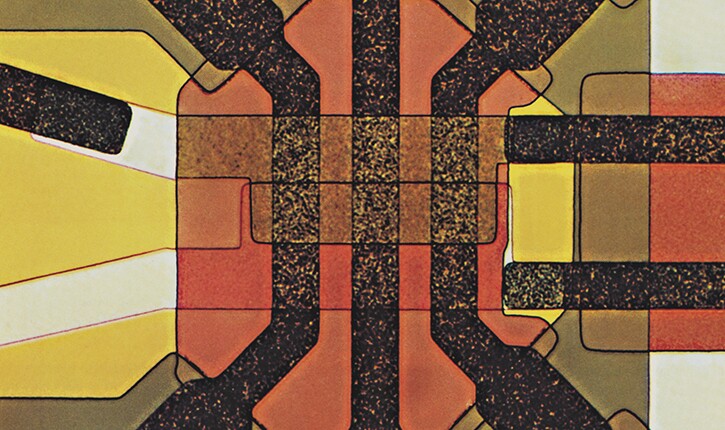
Figure 1. IBM Josephson circuit from 1974. Josephson junctions are formed at the intersection of perpendicular superconducting strips (dark areas) with an insulating oxide layer sandwiched between the two. (Courtesy of IBM.)
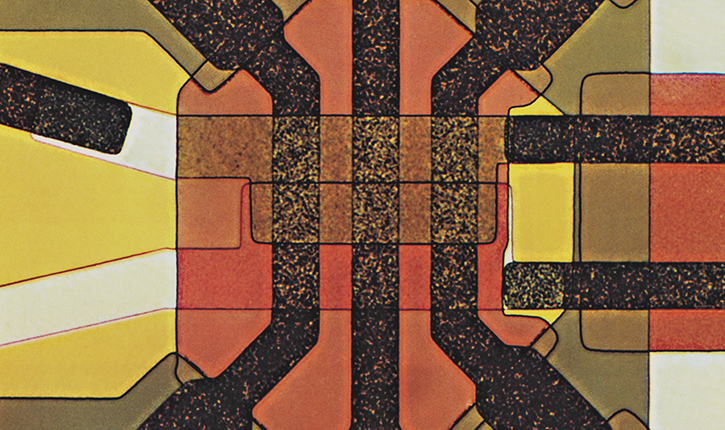
But there’s the rub. Silicon transistors and integrated circuits have been such a successful technology in part because silicon dioxide, an insulator, grows so readily on semiconducting silicon. But nature isn’t so cooperative when it comes to superconductors—it’s not so easy to grow an oxide layer on the kinds of materials that are suitable for Josephson junction logic. Luckily for Matisoo, the superconductivity community of the 1960s rapidly churned out innovative ways to grow insulating layers on superconducting materials. Yet simply growing an insulating barrier wasn’t sufficient—it had to be thin enough to allow electron tunneling, but not so thin that it lost integrity and shorted out.
Despite those difficulties, by 1967 Matisoo had made a demonstration junction with subnanosecond switching and a more complex Josephson-based flip-flop, a circuit to store binary information. Figure 2 shows an oscilloscope trace Matisoo published in 1966 that demonstrated the fast switching capability of a Josephson junction. As Anacker noted later, the results indicated that Josephson logic “could be competitive with projected semiconductor integrated circuits.” 3 Anacker therefore formed an exploratory program to see whether Matisoo’s rudimentary devices could be turned into a real computer architecture. Under Anacker, more personnel were gradually drafted into the effort, they started patenting inventions, and the IBM publicity machine started highlighting their work.
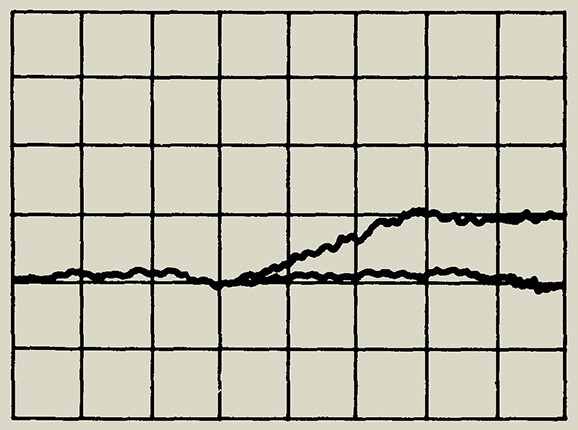
Figure 2. Proof of concept. This oscilloscope trace—gridline spacings are 1 mV (vertical) and 0.4 ns (horizontal)—from Juri Matisoo’s 1966 paper demonstrated that Josephson junctions could switch from a supercurrent, pair-tunneling state (0 V signal) to a dissipative, single-particle-tunneling state (1 mV signal) in less than 1 ns. (From J. Matisoo, Appl. Phys. Lett. 9, 167, 1966.)
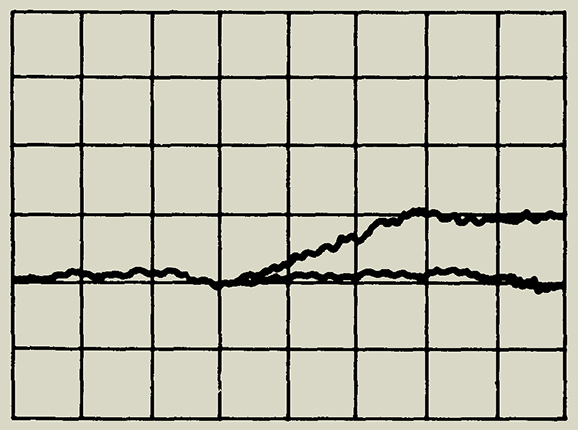
The most likely candidate
Before 1967 Matisoo had been on his own, working hard to catch up with the leaders in the field. As Anacker’s group ramped up, though, IBM shifted from trailing to trailblazing. All eyes turned to Matisoo, Anacker, and their colleagues. Yet the eyes of different groups saw the IBM Josephson program in very different lights. The global superconductivity research community, for instance, began to see IBM as a place where graduate students could get jobs. Other microelectronics firms, somewhat burnt from the cryotron, declined to commit fully to Josephson computing, but they started to develop small defensive efforts out of wariness that IBM would achieve a runaway success. Two firms in particular—AT&T and Sperry—ran Josephson projects about 10% the size of IBM’s.
Two other categories of observer proved especially influential. One category was federal grant officers who thought superconducting circuits might further their agencies’ interests better than conventional silicon. In particular, Fernand “Doc” Bedard, Nancy Welker, and John Pinkston at the NSA began following the IBM program closely in the early 1970s, in hopes that a Josephson computer would have the speed needed to break Soviet codes. The NSA team began traveling regularly to Yorktown while building up their own small in-house research capacity. Then in late 1972, the NSA agreed to bear about a quarter of the costs of the IBM program.
The other, even more influential category of observers were senior researchers and managers within IBM. Indeed, the negative views of superconducting computing expressed by some IBM figures who were not associated with the Josephson program have become almost as famous as the program itself. In particular, Rolf Landauer—otherwise best known for his work on the thermodynamics of information processing that disproved Maxwell’s demon—is today often cited for his criticisms of unconventional microelectronics. He suggested, for instance, that descriptions of quantum computing schemes, some of which incorporate Josephson junctions, include this disclaimer: “This proposal, like all proposals for quantum computation, relies on speculative technology, does not in its current form take into account all possible sources of noise, unreliability and manufacturing error, and probably will not work.” 4
As Landauer’s obituarists pointed out, “He understood what was needed to build a computer very well and along with Robert Keyes tried to pass such knowledge to the promoters of every cockamamie scheme that emerged. As a result he took a dim view of optical computing, [and] logic based on threshold devices, such as Esaki diodes and Josephson junctions.” 5 Keyes, also an IBM physicist, is less well known in the general scientific community, but in certain fields—such as molecular electronics—he has a well-earned reputation as a skeptic and scourge. That reputation rests on comments like the following from 2008, which could apply equally to both today’s molecular electronics and quantum computing and to the Josephson effort of the 1970s: “No solid state rival of the transistor has appeared in the four decades since transistors replaced relays and the vacuum tube. The transistor is unique, and is essential to solid state electronics.” 6
Yet it is not entirely accurate that Landauer, Keyes, or their peers at IBM were so skeptical of Josephson computing at the time. As late as 1975, Keyes was writing that “superconducting devices based on the Josephson tunneling cryotron appear to be the most likely candidate for logic that will make a much larger, faster computer possible.” 7 That’s not a ringing endorsement, but it also doesn’t make Josephson computing sound like a “cockamamie scheme.” Rather, Keyes, Landauer, and other senior IBM researchers and managers were unconvinced but convincible—they wanted Anacker and Matisoo to have a chance to show what Josephson junctions could do.
With the NSA’s enthusiastic endorsement and the more lukewarm support of IBM peers, the Josephson program made rapid progress in the early to mid 1970s. A group at the IBM research lab outside Zürich joined the effort, focusing more on advanced materials and memory, while Yorktown emphasized logic and system architecture. With new personnel came more rapid innovation—the effort’s rate of patenting from 1973–78 was approximately twice that of 1968–73. In 1977 Ralph Gomory, IBM’s director of research, approved a further expansion with the aim of proving or disproving the commercial feasibility of a Josephson computer once and for all. The number of personnel peaked at around 125 people in the early 1980s. By that point, the effort cost approximately $20 million per year (more than $50 million in today’s dollars), about a quarter of which was supplied by the NSA.
How far, how fast?
By 1980 IBM’s investment in Josephson logic had become big enough that upper management wanted to know just how competitive with silicon it actually was. The task of formally making the comparison between Josephson logic and silicon logic fell to Emerson Pugh—presumably because he was a physicist and a manager with experience in product development. Incidentally, Pugh was also an accomplished historian of product development at IBM. He assembled a team of semiconductor and superconductor specialists to conduct an “extendability study” that compared Josephson logic with silicon bipolar-transistor logic. Extendability here meant that Pugh’s committee had to predict how far silicon bipolar logic would improve over the next 15 years and to figure out whether Josephson logic had any chance to improve on a steeper curve that would overtake silicon.
The results were ambiguous. Pugh’s committee estimated that a Josephson chip could, someday, be anywhere from three to six times as fast as a bipolar chip with the same power dissipation. However, the extendability study also outlined several potential obstacles to mass-producing Josephson chips. One problem stemmed from the fact that all the gates in a chip were supposed to reset at the end of every clock cycle—but in a situation known as punch through, individual gates had a small but nonzero probability of failing to reset.
The study team also found reasons to be more optimistic about bipolar technology than had seemed justified when the Josephson program began. The industry’s ability to miniaturize silicon circuits without running into crippling power dissipation problems had surpassed all hopes. A switch to superconducting circuits thus seemed less necessary.
As might be expected, the ambiguous predictions were interpreted quite differently by advocates and critics of Josephson computing. The NSA and the leadership of IBM’s Josephson effort seem not to have found anything in the extendability study to imply that the program should be shut down. By contrast, senior silicon specialists seem to have felt that Pugh’s committee had demonstrated that Josephson logic was unlikely to outcompete silicon and that IBM should therefore downsize its efforts in superconducting computing. As physicist Robert Gunther-Mohr wrote in a letter to Gomory,
I believe this has been [a] useful effort. It has increased mutual awareness between the Silicon and the Josephson efforts in IBM and has helped us understand both opportunities and limitations more comprehensively than before… . I believe a factor of at most 3 between CIL/JSP [Josephson] Technology and Silicon, with all the technical uncertainties, gives an insufficient justification for [the Josephson effort without] … significant changes in program directions.
8
I believe this has been [a] useful effort. It has increased mutual awareness between the Silicon and the Josephson efforts in IBM and has helped us understand both opportunities and limitations more comprehensively than before… . I believe a factor of at most 3 between CIL/JSP [Josephson] Technology and Silicon, with all the technical uncertainties, gives an insufficient justification for [the Josephson effort without] … significant changes in program directions. 8
Again, like Keyes and Landauer, Gunther-Mohr doesn’t sound like someone who considered Josephson computing a “cockamamie scheme.” He remained unconvinced, but perhaps still convincible. Nevertheless, the window in which people like Gunther-Mohr could be convinced was starting to close. One of Pugh’s recommendations had been for a task force to weigh continuation or cancellation of the program within nine months. When that task force met at the end of 1980, 12 of its 15 members voted for cancellation.
One of the three who favored continuing was Joseph Logue, an electrical engineer and manager who had contributed to IBM’s transition to transistors in the 1950s and to integrated circuits in the 1960s—for which he was made an IBM fellow, the company’s highest honor. Logue’s reasoning was that “the program had been so badly mismanaged that it was difficult to determine if the basic problem was mismanagement or technology” and that therefore he couldn’t vote for cancellation until a more competent manager had shown the technology’s true potential. 9 Now, that’s not a view of Anacker’s management abilities that I’ve heard affirmed by any of the Josephson project veterans I’ve talked with. But, of course, many of Anacker’s subordinates were fellow researchers who, Logue felt, weren’t sufficiently committed to getting a product to market. “Many of the 50 PhDs on the team,” he said, “were more interested in work that would lead to an individual publication than in working as a team to advance the program.” 9
Again, most of the veterans of the Josephson effort whom I’ve met would disagree with that characterization. But they also acknowledge that under Anacker various basic design choices—such as whether to make the Josephson junctions out of lead or niobium—had remained undecided for long periods of time. For someone like Logue, the ability to finalize design decisions and move on to figuring out manufacturing issues would’ve been a minimum standard of competent management. Thus Logue convinced Gomory not to cancel the program but to find a new director—and, as it turned out, Logue himself was “the only one insane enough” to take on the job, on condition that he be given “two years to determine if the program would fly.” 9
Discovered by expensive experience
Naturally, manufacturing took a higher priority under Logue. To acquaint themselves with manufacturing considerations, the Yorktown researchers actually built a small fabrication line inside the Watson Research Center. The Yorktown line only made small numbers of devices—its purpose was not to mass manufacture chips but to help the researchers understand what problems might crop up as chips were made. Figure 3 shows a completed assembly of four Josephson chips. However, a true pilot line was built at IBM’s manufacturing facility in East Fishkill, New York, and some Yorktown researchers were transferred there to oversee the line’s construction and operation.

Figure 3. Prototype chips. In the early 1980s, IBM fabricated experimental Josephson chips to test their performance and identify potential manufacturing problems. This photograph shows a chip assembly containing two cards (large squares). Two 6.4 mm × 6.4 mm Josephson chips (small squares), are attached to each card. (Courtesy of IBM.)
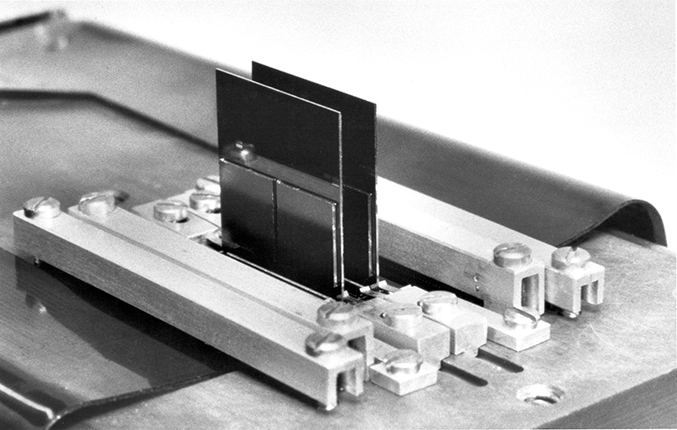
Thanks to IBM’s publicity machine, all that activity drew the attention of the press. Newspapers and magazines from Science to the Economist to Business Week published frequent articles in the late 1970s and early 1980s extolling IBM and predicting that Josephson logic “may initiate a new era of extremely rapid processing equipment.” As National Geographic, of all places, put it in October 1982,
Researchers at Bell Labs, IBM, and elsewhere are refining Josephson junctions—electronic switches made of metals that lose all resistance to electric current when chilled to near absolute zero. Chips with these devices can switch signals in seven-trillionths of a second, presaging ultrafast telephone switching equipment, or a refrigerated supercomputer. Its chilled circuits could be packed into the volume of a grapefruit, cutting travel time for signals and enabling the machine to carry out 60 million instructions a second, ten times as many as current high-performance computers.
IBM hopes to build a prototype in a few years. “Could it be of commercial significance?” IBM’s Dr. [Lewis] Branscomb baited me. “I’ll tell you in the 1990s.”
10
Researchers at Bell Labs, IBM, and elsewhere are refining Josephson junctions—electronic switches made of metals that lose all resistance to electric current when chilled to near absolute zero. Chips with these devices can switch signals in seven-trillionths of a second, presaging ultrafast telephone switching equipment, or a refrigerated supercomputer. Its chilled circuits could be packed into the volume of a grapefruit, cutting travel time for signals and enabling the machine to carry out 60 million instructions a second, ten times as many as current high-performance computers.
IBM hopes to build a prototype in a few years. “Could it be of commercial significance?” IBM’s Dr. [Lewis] Branscomb baited me. “I’ll tell you in the 1990s.” 10
In fact, in less than a year the program would be dissolved. After Logue’s stipulated two years directing the effort, Pugh was called on again to conduct an extendability study, this time comparing both Josephson and gallium arsenide circuits with conventional silicon bipolar circuits. And this time the results were unambiguous. Josephson technology now seemed less certain to work, and even the most optimistic estimates made it seem less competitive with silicon. Resolving punch through and other noise problems with Josephson circuits would require manufacturing compromises that decreased their top speed, and it seemed less likely than before that Josephson-based memory cells could be miniaturized much further. On 23 September 1983, the program was canceled.
So how should we understand IBM’s Josephson computing program? It was, at first glance, a very expensive failure, costing something on the order of a quarter billion of today’s dollars. All the program veterans I’ve talked to have come around to the conclusion that canceling it was justified—though many were not so reconciled at the time. Even today they can’t all agree on why the decision was justified: Some point to the problems with miniaturizing Josephson memory, some to the punch-through problem, some to the surprisingly long continuation of Moore’s law in silicon.
Already in 1983 there were some at IBM who thought the program had gone on for far too long. At the time of the second extendability study, one wag sent Pugh a series of cartoons that had been doctored to humorously criticize him for not killing the program in 1980. One cartoon showed a man seated at a desk labeled “E. Pugh” talking to a colleague while an elephant drank water behind him: “Okay … but except for that when have I ever made a bad mistake?” Pugh’s friend signed the cartoon “To Emerson—one more time” and also included a New York Times article that contained the warning that in New York State, “the code of Criminal Procedure provides that persons ‘pretending to forecast the future’ shall be … liable to a fine of $250 and/or six months in prison.”
Perhaps the wag’s most perceptive cartoon was one showing a depressed man trapped in a bottle labeled “Josephson.” Another man points gleefully at him; both men, though, are trapped in a larger bottle labeled “silicon.” That is, silicon integrated circuits do have real limitations. It wasn’t clear at the start of the Josephson program which bottle was inside the other. As Keyes recollected in 1985, “The speed advantage of a Josephson computer may not be as great as was hoped when silicon circuitry was in an earlier stage. It is hard to see such restrictions on the applicability of a technology in advance, they must be discovered by expensive experience.” 11 Landauer, too, seems to have agreed that IBM’s effort had been costly but worthwhile:
There are many advanced technology proposals which become major thrusts, only to be abandoned again subsequently. An adventurous technological climate has to reward the taking of risk, and must allow failures.… Some technological candidates, such as Josephson junction logic, magnetic bubble storage, or the battery powered automobile, did deserve real examination. When they are discarded, it is done with trepidation, and knowledge that the decision may not last forever.
12
There are many advanced technology proposals which become major thrusts, only to be abandoned again subsequently. An adventurous technological climate has to reward the taking of risk, and must allow failures.… Some technological candidates, such as Josephson junction logic, magnetic bubble storage, or the battery powered automobile, did deserve real examination. When they are discarded, it is done with trepidation, and knowledge that the decision may not last forever. 12
Indirect benefits
Indeed, not everyone agreed that IBM had made the right choice. Reportedly, some NSA personnel were displeased with the program’s cancellation. Similarly, a National Research Council study commissioned by the US Navy the next year called for the federal government to step into the void left by the absence of IBM and Sperry, which canceled its smaller program at the same time. That never happened. The Japanese government did fund a Josephson computing effort from 1981 to 1989, but it ended with the same conclusion as IBM’s program. Silicon had just progressed too fast for superconducting computing to catch up.
Still, it’s difficult to evaluate the IBM Josephson program solely on the basis of whether it was wise to try to beat silicon over the long haul. Prediction, after all, can land you in jail. Yet the value of the program can nevertheless be inferred, in part, from the benefits it brought IBM even though it didn’t yield a product. Most obviously, the two Nobel Prizes in Physics shared among four IBM researchers—in 1986 for the scanning tunneling microscope (STM) and in 1987 for high-Tc superconductors—were related to the Josephson program, if indirectly. None of the four recipients was a member of the Josephson effort, but all four worked with people who were. One inspiration for the STM was the Zürich Josephson team’s need to fabricate very thin films. And according to the joint Nobel lecture by Alex Müller and Georg Bednorz, Müller “started working in the field of superconductivity” during a sabbatical at Yorktown in 1978–79, where he was well known to members of the Josephson effort.
More directly, Josephson computing generated a stack of around 90 patents and valuable, mostly free advertising for IBM in Business Week, the Economist, and other magazines. It contributed to the storehouse of knowledge too. Particularly valuable to IBM managers was the knowledge that silicon was here to stay. But the rest of us learned something as well: As a retrospective account noted, “Near the end of the Josephson computer program there was a realization by the IBM management and technical workers that good science could be done with technology developed by the Josephson computer team.” 13
Most valuable, I would argue, were the personnel who participated in the Josephson program. Some later contributed to IBM’s intellectual-property portfolio in areas quite unrelated to superconductivity. Some, particularly IBM fellow Carl Anderson, helped save IBM from bankruptcy in the early 1990s by transitioning its product line from chips based on bipolar transistors to ones based on MOSFETs. A few were able to apply their experience in the Josephson program directly—for instance, in IBM’s later, similar forays into compound semiconductors. When a bandwagon formed around high-Tc superconductors in the late 1980s, Josephson program veterans represented IBM in Washington, DC, as the science-policy establishment tried to fashion a response. They also ensured IBM’s participation in the products of post-high-Tc policy, such as the George H. W. Bush administration’s baby, the Consortium for Superconducting Electronics. Several Josephson program veterans climbed high in IBM’s ranks, including Matisoo, who went on to run the firm’s Almaden research lab.
What chance today?
It’s not clear that we still live in a world that can afford expensive, if valuable, failures such as IBM’s Josephson computing program. Corporate basic research has declined considerably since the 1960s. The employer of a present-day Matisoo would probably not give him permission to grab some unused evaporators and try to make a circuit based on the seemingly far-fetched ideas of a 22-year-old Welshman. A present-day Anacker would have a much harder time forming a program to overthrow silicon integrated circuits, bringing the NSA on as a patron, and building it up over 15 years to a 125-person, $50 million per year effort.
The assumption in industry and science policy circles today is that universities and consortia can take on much of the science-based technology development work that firms like IBM used to do in-house. But what university could sustain even a fraction of IBM’s Josephson effort? If we want to entertain the possibility of beyond-CMOS microelectronics, then examples such as the IBM Josephson program should remind us of what might be needed to attain that possibility. As Landauer advised, “An adventurous technological climate has to reward the taking of risk, and must allow failures.”

IMAGE BY FRITZ GORO AND HANS LUHN/IBM
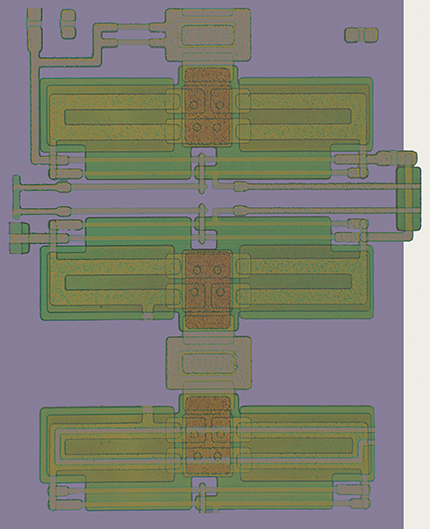
This article is an adaptation of a chapter from the author’s upcoming book, The Long Arm of Moore’s Law: Microelectronics and American Science, MIT Press.
References
1. D. C. Brock, IEEE Spectr. 51(4), 54 (2014). https://doi.org/10.1109/MSPEC.2014.6776306
2. J. Bremer, IEEE Hist. Cent. Newsl. 75, 6 (November 2007).
3. W. Anacker, IBM J. Res. Dev. 24, 107 (1980). https://doi.org/10.1147/rd.242.0107
4. S. Lloyd, Nature 400, 720 (1999). https://doi.org/10.1038/23376
5. C. H. Bennett, A. B. Fowler, Rolf W. Landauer 1927–1999: A Biographical Memoir, National Academy of Sciences (2009), p. 10.
6. R. W. Keyes, J. Comput. Electron. 7, 449 (2008), p. 453. https://doi.org/10.1007/s10825-007-0171-5
7. R. W. Keyes, Proc. IEEE 63, 740 (1975), p. 760. https://doi.org/10.1109/PROC.1975.9825
8. G. R. Gunther-Mohr to R. E. Gomory (9 June 1980), Folder 6, Box 476, IBM Corporate Archives, Somers, NY.
9. J. C. Logue, IEEE Ann. Hist. Comput. 20(3), 55 (1998), pp. 66–67. https://doi.org/10.1109/85.707575
10. A. A. Boraiko, Natl. Geogr. 162(4), 421 (1982), p. 444.
11. R. W. Keyes, Opt. Acta 32, 525 (1985), p. 534. https://doi.org/10.1080/713821757
12. R. Landauer, Physica A 168, 75 (1990), pp. 76, 78. https://doi.org/10.1016/0378-4371(90)90359-Z
13. A. P. Malozemoff et al., IEEE/CSC ESAS Eur. Supercond. News Forum 6(21), RN28–2 (2012), p. 4.
More about the Authors
Cyrus Mody is a professor and the chair of history of science, technology, and innovation at Maastricht University, in Maastricht, the Netherlands.

